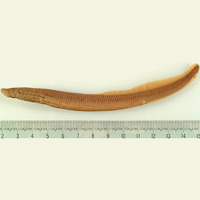Northern Brook Lamprey
Scientific name: Ichthyomyzon fossor

Photo credit: University of Michigan Museum of Zoology, Fish Specimen Image Collection
Status
Special Concern
“Special Concern” means the species lives in the wild in Ontario, is not endangered or threatened, but may become threatened or endangered due to a combination of biological characteristics and identified threats.
Date added to the Species at Risk in Ontario List
The Northern Brook Lamprey was already assessed as a species at-risk when the Endangered Species Act, 2007 took effect in 2008.
Read the most recent assessment report (PDF).
What it looks like
The Northern Brook Lamprey is a small, elongate fish that grows to a maximum length of 16 centimetres in Ontario. It has an eel-like appearance and the characteristic features of a lamprey including a round, jawless mouth with teeth arranged in a circle and seven gill openings and no pectoral or pelvic fins . It is very difficult to distinguish this species from the other native lamprey, but biologists rely on its small size, continuous dorsal fin, and the teeth.
Adults are dark greyish-brown on the back and sides, with pale grey or silvery white on the belly.
The Northern Brook Lamprey has two stages of development – larval and adult. When the eggs hatch, the larvae, called ammocoetes, make burrows in soft mud and spend about six years growing. Once developed, they emerge in the spring from the sediment and disperse as adults to the spawning grounds. They die shortly after spawning has occurred.
Where it lives
The Northern Brook Lamprey inhabits clear, coolwater streams. The larval stage requires soft substrates such as silt and sand for burrowing which are often found in the slow-moving portions of a stream. Adults are found in areas associated with spawning, including fast flowing riffles comprised of rock or gravel.
Spawning occurs in May and June. The males construct small, often inconspicuous, nests by picking up pebbles with their mouths and moving them to form the rims of shallow depressions. The sticky eggs are deposited in the nest and adhere to the substrate.
Where it’s been found in Ontario
In Ontario, the Northern Brook Lamprey range extends from west of Thunder Bay along the northern shores of the Great Lakes and includes the Ottawa River. In the Great Lakes, the species is found in tributaries of Lakes Superior, Michigan, Huron and Erie, but has not been found in Lake Ontario. Northern Brook Lamprey has also been documented in Lake Nipissing and its tributaries.
What threatens it
The use of lampricide for the control of the invasive Sea Lamprey (Petromyzon marinus) has likely contributed to declines in Northern Brook Lamprey populations around the Great Lakes where the two fishes coexist. Additional threats to the Northern Brook Lamprey include pollution, changes in water levels and temperature due to climate change or water management, and predation of eggs and larvae by larger fish.
Action we are taking
While special concern species do not receive species or habitat protection under the Endangered Species Act, 2007, the act requires us to prepare recovery guidance for special concern species, unless a recovery strategy or management plan is required for the species under the federal Species at Risk Act 2002.
All species listed on the Species at Risk in Ontario List may be eligible for consideration for government funding through the Species at Risk Stewardship Program.
What you can do
Report a sighting
Submit your observations of species at risk to the Natural Heritage Information Centre (NHIC), which is Ontario’s conservation data centre. Join the centre’s Rare Species of Ontario project in iNaturalist, an online plant and animal identification app, to quickly and easily submit your observations.
Volunteer
Volunteer with your local nature club or provincial park to participate in surveys or stewardship work focused on species at risk.
Be a good steward
- Land owners can help improve fish habitat and keep Ontario’s water safe and clean by maintaining natural vegetation next to creeks and rivers, and keeping pollution and soil from washing into Ontario’s rivers.
- Private landowners have a very important role to play in species recovery. If you find species at risk on your land, you may be eligible for stewardship programs that support the protection and recovery of species at risk and their habitats, such as the Species at Risk Stewardship Program.
Report illegal activity
Report any illegal activity related to plants and wildlife to
Quick facts
- Unlike some other lamprey species, the Northern Brook Lamprey is non-parasitic and does not attach itself to larger host fish. The larvae are filter-feeders, consuming microscopic plant and animal life and decaying matter. Adults have a non-functional intestine and do not feed.
- Multiple adults may spawn in the same nest, and multiple males may spawn with the same female. Female Northern Brook Lamprey can lay over 1,000 eggs.
- Lamprey species are one of the most ancient freshwater fish families in the world.
- Lampreys are similar to sharks in that they do not have bones, but rather a cartilaginous skeleton.